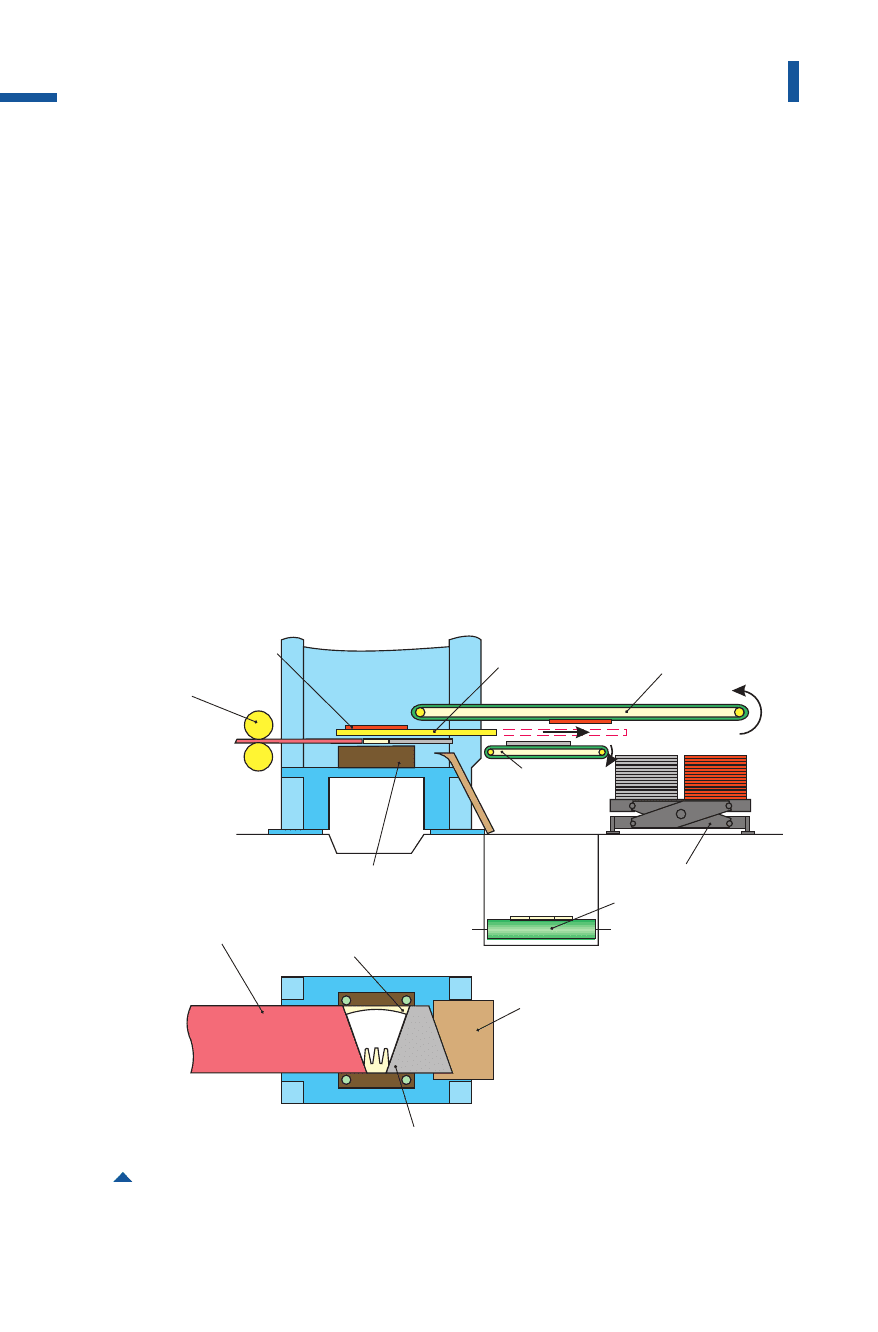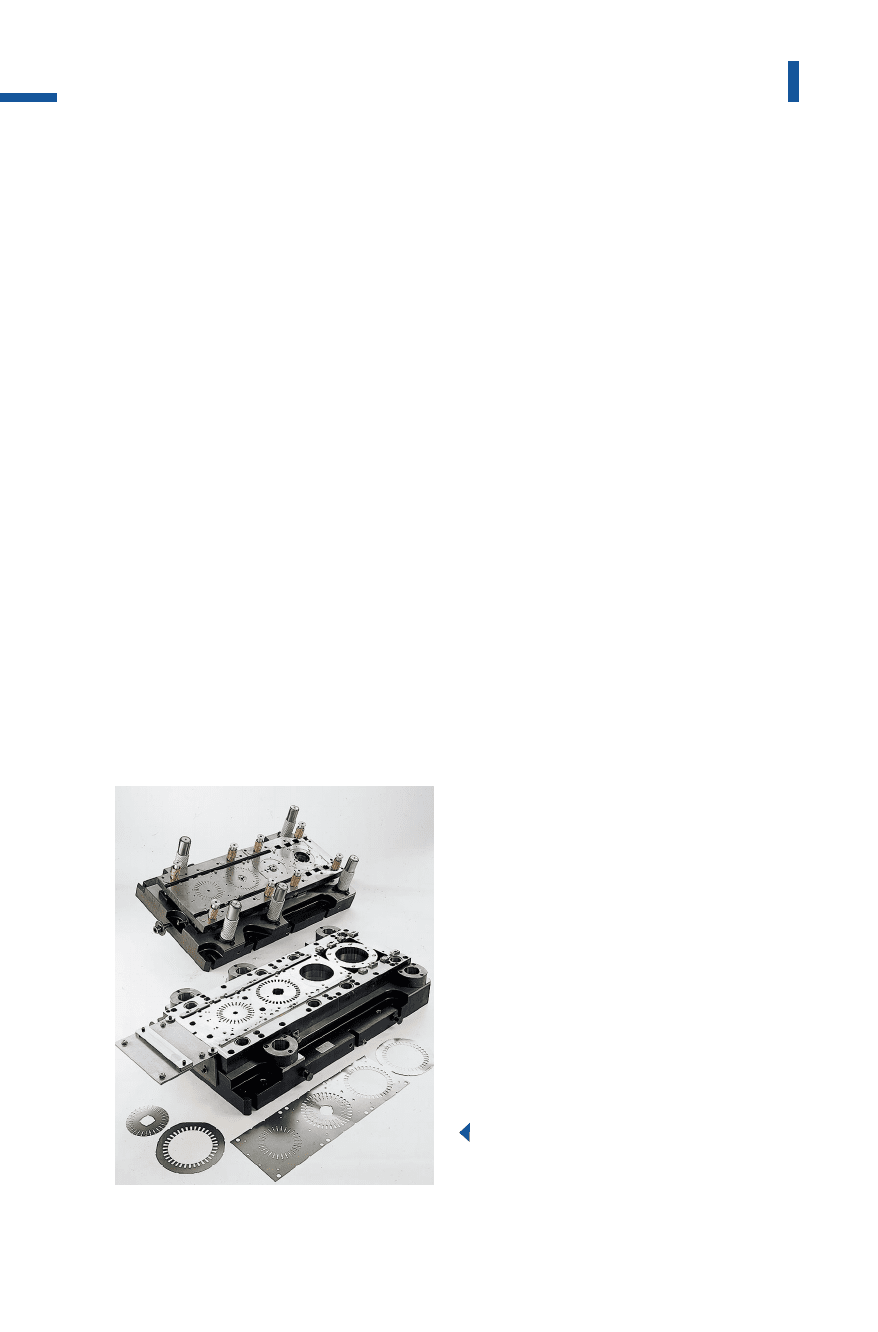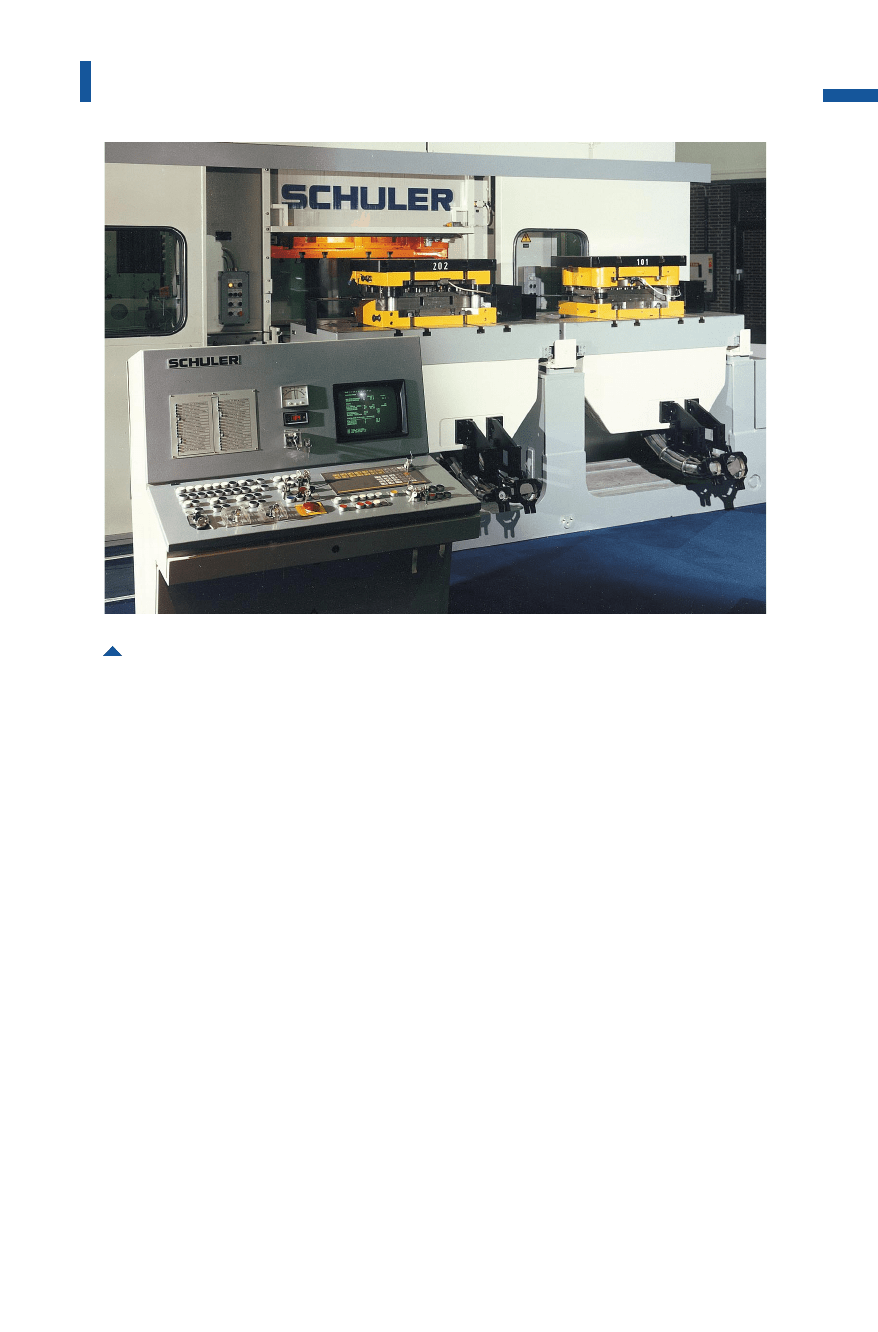Altan T. Metal Forming Handbook
Подождите немного. Документ загружается.


Depending on the blank geometry, flexible notching systemswork
with transfers or robots.In this case, transport always takes place from
one pallet to the next (Fig. 4.6.17). The standard number of five sta-
tions can be extended at will. As for semi-automatic notching ma-
chines with numerical control, flexible automatic notching lines are
particularly suited for the manufacture of complex blanks: The same
selection criteria apply concerning controllable dies. At a higher level
of automation, automatic notching machines can be individually
adjusted to specific production processes. One such device joins baked
enamel-coated laminationsto create a complete lamination stackof the
type used in electric motors. The stator blanks are individually heated,
inserted in a basket-like device. Pressure is applied onto the complete
stack with each inserted lamination. A measurement device guaran-
tees a consistent stack height. Once the required stack height has been
reached, the basket-like device containing the laminated stack is swiv-
elled out. The pressing process is carried out while the next stack is
being formed. This curing period allows the coating on the lamina-
301
Shearing lines
Fig. 4.6.15 Complete blanking die for the production of segment blanks
Metal Forming Handbook / Schuler (c) Springer-Verlag Berlin Heidelberg 1998

tions to harden, fusing the stack together. The stack is then ejected
onto a roller conveyor.
Using a particularly flexible automation method, two individual
notching machines with pallet magazines and pallet storage stations
are linked by means of a pallet handling system. A host computer is
responsible for joint control. This allows both lines to produce stator
and rotor laminations for one size electric motors or for different inde-
pendent sizes.
302
Sheet metal forming and blanking
Fig. 4.6.16
Automatic notching line for the production of stator and rotor laminations in two
passes with one notching machine (above) and in a single pass with two notching
machines (below)
1
6
5
4
3
2
1
6
7
8
5
4
3
2
position rotor blanks
notching machine:
notch rotor
deposit rotor
laminations
rotor blanks
/
deposit rotor
destack blanks
destack blanks
/
destack rotor blanks
orientation
orientation
notching machine:
notch stator and
separate
rotor
notching machine:
notch stator and
separate
rotor/notch
rotor
deposit stator blanks
deposit stator blanks/idle station
idle station
punch finish shaft hole
Metal Forming Handbook / Schuler (c) Springer-Verlag Berlin Heidelberg 1998

In general, large-scale special motors are custom-produced using blanks
which require up to seven different blanking operations (Fig.4.6.11).
The unproductive downtime involved in this type of process can account
for over 50% of the total production time as a result of the resetting
and handling work involved. For this reason, these blanks are most
economically produced using aflexible production cellwhich requires
only a single clamping operation. A central robot is responsible for all
handling functions and also for fully automatic die change. If the
blanks and dies are placed ready for processing during normal working
hours, the production cell is capable of operating unmanned round the
clock.
303
Shearing lines
Fig. 4.6.17
Flexible automatic notching machine with robot and pallet magazine (nominal press
force 250 kN)
Metal Forming Handbook / Schuler (c) Springer-Verlag Berlin Heidelberg 1998

Notching machines can be equipped with supplementary attachments
for special applications. These include devices for the production of
–interrupted hole patterns,
–tapered lamination stacks and
–skewed lamination stacks.
Blanking lines with complete blanking dies
Medium-sized batches of electric motors, finished segments, raw seg-
ments and pole blanks are generally produced using complete blanking
dies (Fig.4.6.13). Here, the external contours, holes and notches are
blanked in a single work process, generally using straight-sided presses
(cf. Fig.3.1.1).The press concept used here is similar to that of univer-
sal mechanical presses (cf. Sect. 4.4.1). It is also possible to manufacture
circular blanks, which are frequently used for further processing in
notching machines. The width of the individual blanks, strips or coil
material can be anywhere between 300 and 1,250mm. These presses
are constructed for blanking forces ranging from 1,250 to 5,000 kN. The
stroking rate can be adjusted continuously between 15 and 150 strokes
per minute depending on the size of the machine and the process engi-
neering concept used.
The diesare often constructed in such a way that the punch with the
outside contours is located in the bottom die holder and the female die
is located in the upper die holder. Several parts can be produced simul-
taneously. In some cases, the scrap is punched by the bottom die.
The separate stripper plate in the bottom die strips the scrap web
while the ejector in the upper die ejects the finished part. This requires
a plate or crossbar ejector in the press slide which is active near the top
dead center.
The gib columns generally extend out of the gib bushes when the die
opens. Therefore, they are usually manufactured of steel, while the gib
bushes are made of bronze. The coil guiding elements are combined
with the stripper plate.
As a single-unit welded construction, the press body is configured for
a high degree of rigidity. Considering that high-quality blanking dies
are used, the precision of the slide gib is of particular importance. The
eight-track roller gib system has proven to be an ideal system here
(cf.Fig. 3.1.6).The slide is equipped with a total of 16 roller elements,
304
Sheet metal forming and blanking
Metal Forming Handbook / Schuler (c) Springer-Verlag Berlin Heidelberg 1998

which run, backlash-free, along hardened gib rails. Should the slide
become inadvertently jammed, the press can be quickly released with
the aid of hydraulic oil cushions under the connecting rods.
In earlier systems, presses equipped with complete blanking dies
required frequently manual loading. Now, however, automatedpart trans-
port is increasingly becoming a customary feature. But this is only possi-
ble where machines are equipped with coil lines (cf. Sect. 4.3) or blank-
loaders (cf.Sect.4.4.4) and part discharge devices. The press dimensions
are determined accordingly not only by the width of the coil stock being
processed and the necessary press force and the die dimensions, but also
by the greater space required to accommodate add-on units.
The processing of coil stock using a coil linerequires the use of a decoil-
er and straightening device as well as an efficient feed system at the press.
For small coil stock widths, a dual decoiler is generally used, while wider
coils are processed by a single decoiler with a coil lifting platform. A coil
loading car is also capable of accommodating two or three large coils.
The electronically controlled roller feed system has proven to be
highly popular for material feed.It is driven by a threephase servomotor
with control circuit, which allows the feed phase to be set depending
on the slide stroke and die engineering concept. Today, state of the art
presses are generally equipped only with one feed device at the materi-
al infeed side.
Individual components, such as unfinished segments, are inserted
into the die by a mechanically or electrically driven blankloader. The
roller feed for the coil stock and the blankloadercan be combined with
a vertical adjuster in such a way that one of the two is selected to be in
operation at any one time.
Using a plate-like feed device, the blankloader transfers the blanks
from the stack, which is raised by a lifting platform, to the press. The
electrical device is driven by a threephase servomotor and chain trans-
mission. Output is limited to some 20 blanks per minute. Mechanical
transfer systems driven directly by the eccentric shaft of the press via
cam indexing gears are able to transport up to 40 blanks per minute
depending on the part size.
Removal of the scrap webfrom the tool area is performed by a power-
driven magnetic roller. The scrap web created by the blanking process is
finally chopped by a cropping shear positioned on the outfeed side of
the press.
305
Shearing lines
Metal Forming Handbook / Schuler (c) Springer-Verlag Berlin Heidelberg 1998

In the case of automatic part discharge, the stroke of the press slide lies
between 150 and 300mm due to the long discharge period. An
adjustable slide stroke offers the advantage that progressive dies with a
small stroke of for example 40 mm can be used to optimum effect (cf.
Fig. 3.2.13).Mechanical discharge devices which are either directly dri-
ven or controlled by the press are generally used.
The parts are ejected when the press is at its top dead center and they
are collected bydischarge plates,which deposit them outside the press on
a magnetic belt, as illustrated in Fig. 4.6.18for a finished segment.
Depending on the part size, this method limits the stroking rate of the
press to between 20 and 60 parts per minute. This requires a slide stroke
of 150 to 300mm. Due to the long slide stroke required, a part discharge
method has been developed in which the punched parts are collected
and pushed out by two raised lugsin the scrap web (Fig. 4.6.19).The dies
can be operated with a substantially smaller slide stroke of 70 mm, so
306
Sheet metal forming and blanking
Fig. 4.6.18 Discharge plate and destacking magnetic belt for an unfinished segment
magneticbeltfor
finishedparts
scrapconveyorbelt
rollerfeed
liftingtable
finishedsegmentblank
dischargebelt
forunfinished
segments
dischargeplate
scrapweb
unfinishedsegment
coilstock
scrapchute
completeblankingdie
Metal Forming Handbook / Schuler (c) Springer-Verlag Berlin Heidelberg 1998

that up to 150 strokes per minute can be achieved depending on the
part size. This is only possible using a special ejector in the slide, which
ejects the part around 10 mm after the bottom dead center and deposits
it on the scrap web. During the subsequent feed movement, the blank
is engaged by the raised lugs and pushed out of the die. Behind the die
is a magnetic belt which takes the part and transports it in an overhead
position. The scrap web is chopped either directly behind the die or
using a separate cropping shear.
In comparison with conventional discharge systems, this method
permits the output to be doubled, so ensuring the economical applica-
tion of complete blanking dies. However, this method can only be used
when only one finished part is produced at a time and where the out-
side shape of the part permits discharge using raised lugs in the scrap
web.
307
Shearing lines
Fig. 4.6.19 Discharge of finished parts by lugs stamped into the sheet metal strip
magneticbeltfor
finishedparts
scrapconveyorbelt
rollerfeed
liftingtable
magneticroller
croppingshear
finishedpart
scrapweb
finishedblank
withshafthole
coilstock
completeblankingdie
scrapchuteforshafthole
scrapchute
transportluginthe
scrapweb
Metal Forming Handbook / Schuler (c) Springer-Verlag Berlin Heidelberg 1998

High-speed blanking lines with progressive blanking dies
Large series of rotor, stator and magnetic laminations are produced
using progressive blanking dies on high-speed blanking lines, in which
coil stock feed, part discharge and frequently also die changes are all
automatic (cf. Sect.4.6.3). In progressive blanking dies, piercing and cut-
out are executed first for the rotor and then for the stator (Fig. 4.6.20). At
feed rates of up to 100m/min over 1,000 parts per minute can be
punched. Where small feed distances are involved, output is limited by
the press stroking rate, while in the case of larger feed steps the output is
limited by the feed system.
Small blanks are frequently discharged using stacking channels.
Often, considerable time – up to three hours – is required for changeover
of the stacking channels in magnetic lamination production. Therefore,
automatic die change systems have been developed which permit lines
to be automatically reset in less than 10min. As a rule, these systems
comprise a die change cart capable of accommodating two dies, actua-
tors and positioning devices for the axes to be traversed, and a dialogue-
oriented, programmable logic controller. The dies are exchanged com-
plete with mounted and filled stacking channels (Fig. 4.6.21).After spec-
ifying the relevant die set, the complete die changing and resetting
process runs fully automatically.
308
Sheet metal forming and blanking
Fig. 4.6.20
Progressive blanking die set for rotor and
stator blanks
Metal Forming Handbook / Schuler (c) Springer-Verlag Berlin Heidelberg 1998

Larger rotor and stator laminations, in contrast, are still arranged in
accordance with their notching pattern in the die, stacked on mandrels
or in magazines up to a preselected stack height and conveyed out of
the press by means of transport systems. A sequence of stacks of vary-
ing heights, for example for ventilated motors, can also be pro-
grammed.
Another method for the ordered unloading of electric laminations is
by punch-bundling (Fig. 4.6.22).For this purpose, additional punches
are located in the die set and they punch for example lugs, cams or neps
into the laminations. During the cut-out process, these raised areas
press the laminations into the corresponding recess in the previously
punched part (Fig.4.6.23).Once the required stack height has been
reached, the following lamination is pierced where the raised area is
prior to bundling by means of a piercing hole punch. This ensures that
the pierced lamination is not able to link up with the previous lamina-
tion and becomes the first lamination of the new stack.
309
Shearing lines
Fig. 4.6.21 Automatic die change using a die changeover cart
Metal Forming Handbook / Schuler (c) Springer-Verlag Berlin Heidelberg 1998

4.6.5 Production and processing of tailored blanks
Welded blanks comprising different materials, thicknesses or coatings
are known as tailored blanks. The most important benefits offered by
tailored blanks are weight savings and also reduction of the number of
parts required to form assemblies, for example in the case of car body
310
Sheet metal forming and blanking
Fig. 4.6.22 Punch-bundled rotor and stator lamination stacks
Fig. 4.6.23 Joining laminations by means of punch-bundling
punch
blank
female
die
punched part
with cams
punched
part without
cams
Metal Forming Handbook / Schuler (c) Springer-Verlag Berlin Heidelberg 1998
